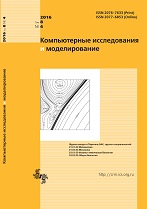|
Modelling the risk of insect impacts on forest stands after possible climate changes
V. G. Suhovol'skiiabc, A. V. Kovalevb, E. N. Palnikovad, O. V. Tarasovac
a V. N. Sukachev Institute of Forest SB RAS
50/28 Akademgorodok, Krasnoyarsk, 660036, Russia
b International Scientific Center for Study of Organism
Extreme State, Krasnoyarsk Scientific Center of RAS,
50 Akademgorodok, Krasnoyarsk, 660036, Russia
c Siberial Federal University, department of ecology and ecological management, 79 Svobodny Av.,
Krasnoyarsk, 660041, Russia
d Siberian State Technological University, department of ecology and forest protection, 82 Mira Av.,
Krasnoyarsk, 660049, Russia
Abstract:
A model of forest insect population dynamics used to simulate of “forest-insect” interactions and for estimation of possible damages of forest stand by pests. This model represented a population as control system where the input variables characterized the influence of modifier (climatic) factors and the feedback loop describes the effect of regulatory factors (parasites, predators and population interactions). The technique of stress testing on the basis of population dynamics model proposed for assessment of the risks of forest stand damage and destruction after insect impact. The dangerous forest pest pine looper Bupalus piniarius L. considered as the object of analysis. Computer experiments were conducted to assess of outbreak risks with possible climate change in the territory of Central Siberia. Model experiments have shown that risk of insect impact on the forest is not increased significantly in condition of sufficiently moderate warming (not more than 4∘C in summer period). However, a stronger warming in the territory of Central Siberia, combined with a dry summer condition could cause a significant increase in the risk of pine looper outbreaks
Keywords:
forest insect, population dynamics, models, modified factors, climate, stands, impact, risks, stress-testing.
Received: 14.02.2016
Revised: 17.03.2016
Citation:
V. G. Suhovol'skii, A. V. Kovalev, E. N. Palnikova, O. V. Tarasova, “Modelling the risk of insect impacts on forest stands after possible climate changes”, Computer Research and Modeling, 8:2 (2016), 241–253
Linking options:
https://www.mathnet.ru/eng/crm141 https://www.mathnet.ru/eng/crm/v8/i2/p241
|

| Statistics & downloads: |
| Abstract page: | 153 | | Full-text PDF : | 95 | | References: | 42 |
|




 Contact us:
Contact us: Terms of Use
Terms of Use
 Registration to the website
Registration to the website Logotypes
Logotypes









 Citation in format
Citation in format 